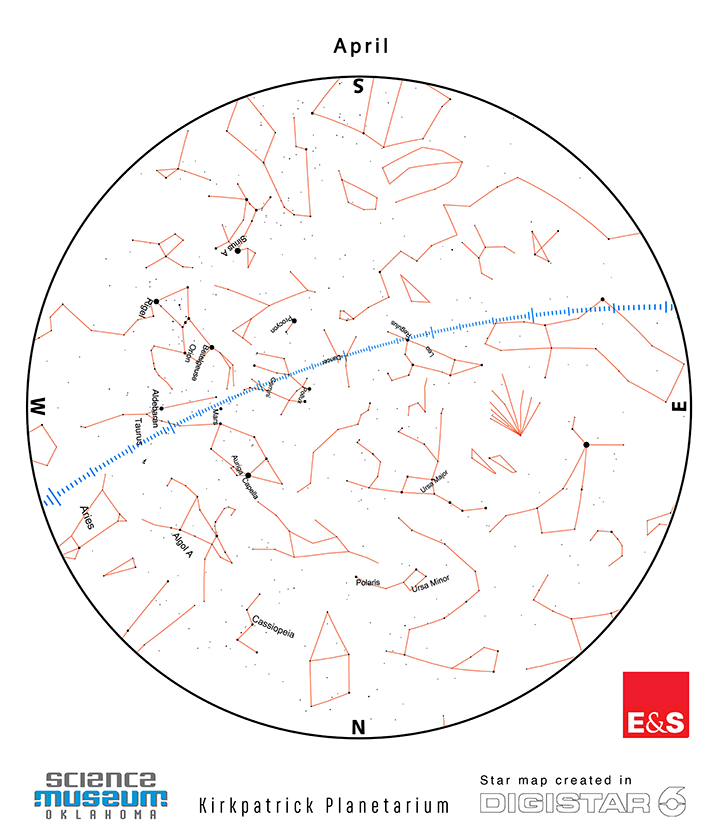Red Dirt Astronomy: Skies & Space for April
March 31, 2023
Planets
Mercury - For the first half of April, Mercury will be incredibly bright shortly after sunset at mag. -1, nearly the same brightness as the brightest star in the night sky, Sirius, which will also be visible in the western evening sky near Orion. This will be the best evening viewing of Mercury for the entire year. During the rest of the month, Mercury will slowly fade to mag. +2, until it meets with a thin crescent moon on the 21st, along with Uranus.
Venus - Venus will continue to be bright and high in the western evening sky throughout the month, as it climbs in elongation from the Sun. As a result, Venus will appear to get wider through a telescope as its phase decreases, making for an excellent observation of the phases of Venus during the month of April. It will meet with a waxing crescent moon a few days after Mercury on the 23rd.
Mars - Also in the western evening sky with Mercury and Venus, Mars will continue to spend its time high up as it approaches the stars of Gemini, only dimming slightly throughout the month of April. It will make a close approach to the waxing crescent moon as well on the 26th.
Jupiter - After a few months of excellent viewing, Jupiter will be too close to the Sun for viewing throughout April. It will make its next appearance in the evening sky beginning in October 2023.
Saturn - Spending the month in Aquarius, Saturn will progressively separate from the Sun throughout April, making for some great early morning viewing, around 5 AM, in the later half of the month. The next time Saturn will be visible in the evening around 9 PM is mid-August. Otherwise, you will have to stay up later to get a view of this ringed giant.
Uranus - Best viewed with a telescope around 9:30 PM throughout April, Uranus will be low in the sky, slowly fading into the sunset towards the end of the month. It makes a close approach to Venus for the first few days of April.
Neptune - Neptune will spend most of the month too close to the Sun for telescope viewing, but will join Saturn in the early-morning sky between Pisces and Aquarius in the later half of April.
Sky & Space Events and Anniversaries: April 2023
April 2nd - Cassini spacecraft confirms water ocean under the surface of Enceladus (2014)
April 6 - Full Moon
April 10 - First image of a black hole published (2019)
April 11 - Mercury at greatest elongation
April 12 - Yuri Gagarin becomes first human in space in (1961)
April 12 - First flight of the Space Shuttle (1981)
April 12 - Discovery of cosmic rays (1912)
April 13- Last Quarter Moon
April 14 - Apollo 13 oxygen tank explosion, canceling the mission and bringing the astronauts back home (1970)
April 17 - Neptune near Moon
April 20 - New Moon
April 21 - Mercury near Uranus and both are near the Moon, Lyrids meteor shower begins
April 22 - Pleiades near Moon, Predicted peak of Lyrids meteor shower Saturday night
April 21- Venus near Moon, Lyrids meteor shower ends
April 24 - The Hubble Space Telescope launched (1990)
April 26 - Pollux near Moon
April 27 - First Quarter Moon
Object of the Month: Lyrids Meteor Shower
With only 20 meteors per hour predicted under a dark sky, the Lyrids are known for uncommon surges, producing over 100 per hour. Named for the constellation of Lyra, many of these meteors leave an ionization trail as they burn up high in the Earth’s atmosphere, sometimes hanging in the sky for several seconds after the meteor has faded. During the weekend of the 21st-23rd, the thin waxing crescent moon will be in the sky, but on the night of the peak, the 22nd, the moon will set around 11 PM, making it the best time to view the event. The radiant -- the point of origin of the shower -- will rise before midnight and be well placed before dawn, located near the bright star Vega in Lyra the harp. Always look for the Lyrids closer to the eastern horizon.



